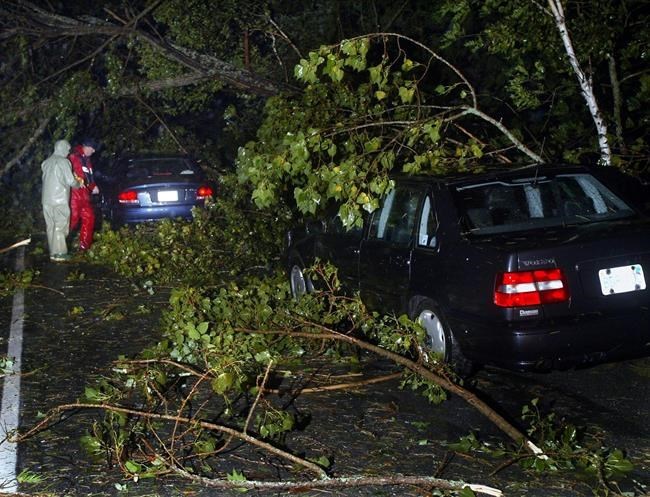HALIFAX — Chris Fogarty remembers the moment 20 years ago when he transmitted a weather bulletin warning that hurricane Juan would make landfall near Halifax, churning out gusts at 140 kilometres per hour.
With the storm's arrival only 36 hours away, the meteorologist with the Canadian Hurricane Centre was worried the alert would be ignored.
"We had gone through almost two decades of very little hurricane impact in Canada," Fogarty said in a recent interview, recalling how Juan would become the most powerful and deadly storm to hit Atlantic Canada in almost 50 years.
"People didn't really have any memory of recent hurricanes .... There was still a sense that we didn't get hurricanes in Eastern Canada."
That sense of complacency stands in sharp contrast to today. In the two decades since Juan made landfall on the morning of Sept. 29, 2003, the East Coast has been lashed by several intense tropical storms, including Igor in 2010, Arthur in 2014, Dorian in 2019 and last fall, Fiona, the most costly weather event in the region's history.
And earlier this month, in the days ahead of post-tropical storm Lee arriving in the Maritimes, there was seemingly endless discussion on social media about weather warnings, computer models, ocean temperatures, barometric pressure and, of course, climate change.
That wasn't the case in 2003 as hurricane Juan barrelled towards Nova Scotia. Few people had smartphones. Facebook, Twitter and Reddit had yet to launch. And there was plenty of skepticism about hurricane forecasts.
"Even with the official warnings out, people were still feeling that the forecasters were overdoing it," Fogarty said.
Ryan Mulligan wasn't one of them.
"With this forecast, I was getting excited because this was directly aligned with my research," recalled Mulligan, who at the time was a PhD student at Dalhousie University in Halifax studying the impact of hurricanes on coastal environments. That excitement was soon replaced by dread as Juan made landfall at 12:10 a.m. near Shad Bay, west of Halifax.
Energized by ocean temperatures that were three to five degrees above normal, the howling Category 2 hurricane brought sustained winds of 152 kilometres per hour amid driving rain. At one point, a weather station atop a lighthouse in Halifax harbour recorded a gust at 176 km/h. Ships nearby recorded even higher wind speeds as the harbour heaved upward, destroying boardwalks and damaging boats.
"It was incredibly scary," Mulligan said, recalling how the storm knocked out power and shook the home he was living in with his wife and two young children. "It wasn't the excitement I was looking for .... It was unimaginably loud. The tops of trees were touching the ground."
Those who experienced the storm said it sounded like a speeding freight train or screaming jet coming in for a landing.
The storm caused power outages that lasted almost two weeks. In Halifax's beloved Point Pleasant Park, Juan toppled more than 80,000 trees. Aerial surveys later showed huge swaths of forested land left in a tangled mess, as if a giant had left footprints across the centre of the province.
Roofs were torn off, billboards were stripped clean and more than 140,000 Nova Scotians were left in the dark. Across the Halifax region, streets were littered with tree limbs, smashed vehicles, dangling power lines and heaps of shingles and siding. More damage was reported in P.E.I., where Juan dropped below hurricane strength.
The storm claimed eight lives. A 31-year-old paramedic was killed when a massive oak crushed the ambulance he was in. A falling tree also killed a man in his car near Enfield, N.S., and two fishermen from Caraquet, N.B., died when their boat sank in the Gulf of St. Lawrence near Quebec's Anticosti Island as the storm raged.
Juan was also blamed for the deaths of a mother and two of her children, whose home was being lit by candles when it caught fire. And a relief worker died weeks later while cleaning up debris.
According to the Insurance Bureau of Canada, the storm caused an estimated $192 million in insurable damage.
"It took at least a week before you could move around in Halifax," said Mulligan, who continues to study the impact of hurricanes on the North American coastline as a civil engineering professor and director of the Beaty Water Research Centre at Queen's University in Kingston, Ont.
Paul Mason, executive director of Nova Scotia's Emergency Management Office, said he was in university when Juan barged in. Like many Halifax residents, he wasn't worried by the forecasts. "They always seemed to fizzle out," he recalled in an interview. "It would either miss us or weaken. It never seemed to live up to the billing."
But Juan's brutal drubbing changed attitudes. "People are much more aware of these dangers resulting from climate change," Mason said. "Juan was an early indicator .... It grounded people a bit."
Where there once was complacency, he said, now there is widespread acceptance of the threats posed by hurricane season.
"We've gone from the conceptual discussions around whether climate change is real ... to now saying, 'We are all seeing this,'" Mason said.
As for Fogarty, he stressed that the technology used to track tropical storms is better than it used to be. The resolution of the current computer models is now eight times higher than in 2003, giving meteorologists a sharper view of how storms are acting.
And the advent of social media has revolutionized the distribution of weather warnings.
"There's a huge difference now when you think of ... the immediate access to data on smartphones," he said. "Juan was a big wake-up call for many people. The awareness and respect for the forecasts has grown over time .... And our confidence in the science is higher."
This report by The Canadian Press was first published Sept. 28, 2023.
Michael MacDonald, The Canadian Press



